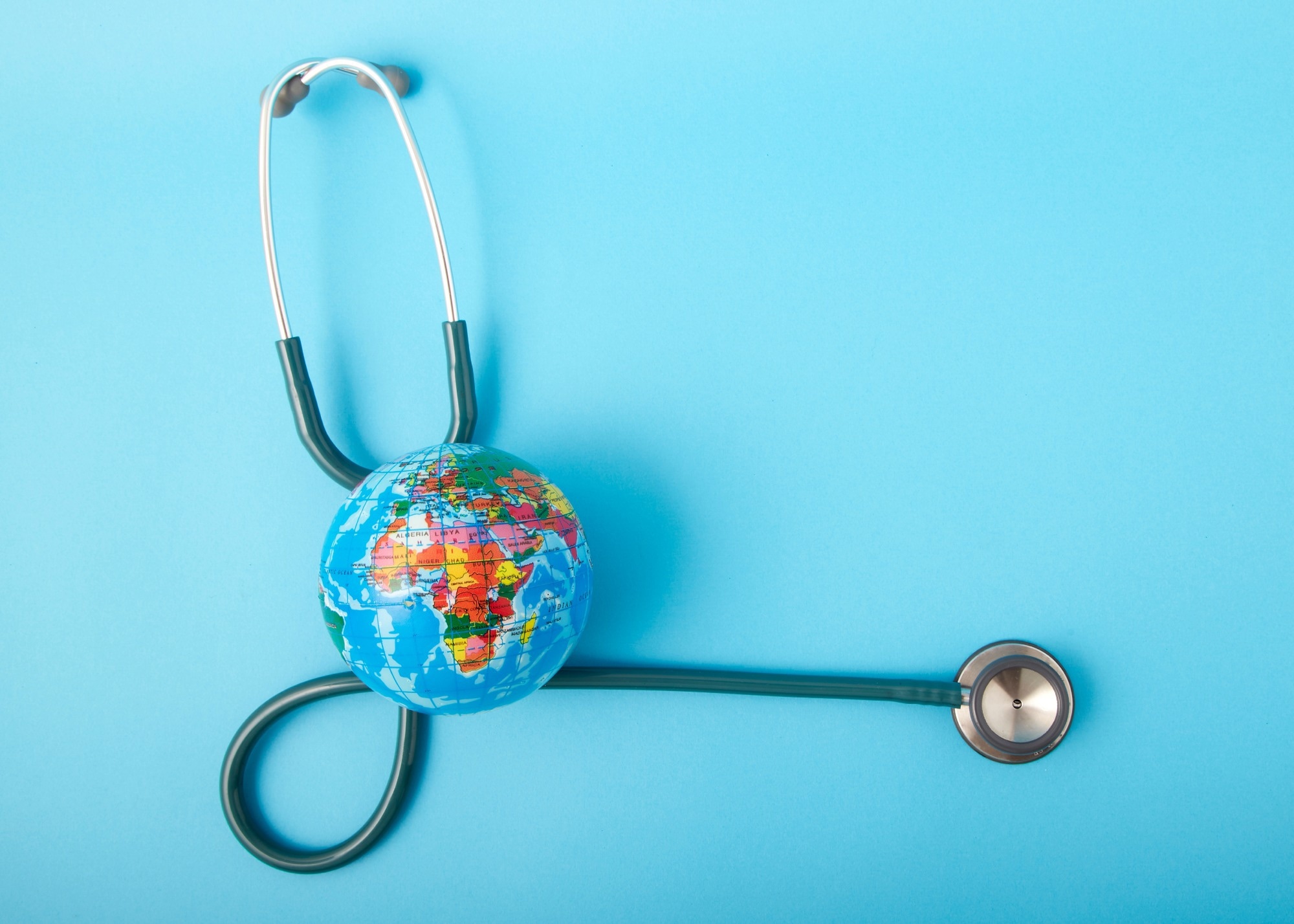The process of developing WHO guidelines
Key WHO guidelines and their global influence
Challenges in implementing WHO guidelines
WHO guidelines in response to health crises
Conclusion
References
Further reading
The World Health Organization (WHO) is an agency of the United Nations Organization (UNO). Founded in 1948, it is dedicated to promoting global health using science-based strategies. Its efforts are directed at expanding universal healthcare, providing leadership during responses to health crises, and promoting health throughout the life cycle. 1

Image Credit: sheff/Shutterstock.com
The global role of the WHO lies in its establishment and monitoring of international standards or guidelines, helping to standardize healthcare services and goals worldwide. In addition, it helps coordinate the many players who participate in achieving common goals. 13
The process of developing WHO guidelines
A WHO guideline “is defined broadly as any information product developed by WHO that contains recommendations for clinical practice or public health policy.” 2
The WHO develops guidelines for all levels of healthcare and patient management based on scientific evidence. This involves asking the right questions, retrieving and putting together the evidence, and evaluating its soundness and reliability. The aim is to promote informed decision-making for each clinical action at the individual or public health level to achieve the best outcomes. 2
Originally intended to address clinical management protocols, WHO guidelines have now expanded into public health policies, healthcare systems, and health promotion strategies. 2
Some of the challenges involved include identifying factors that change the outcome, including interactions between interventions or with the local situation and the effects caused by differing levels of implementation. 3 The WHO has explored the complexity and difficulties of synthesizing evidence and developing guidelines.
Group decision-making is integral to formulating such guidelines. Scanty or conflicting evidence or strongly differing views may hinder consensus, which is, however, the goal attained through discussion and compromise. 4 Stakeholders involved in this process include the group affected, guideline users, quality of evidence, and time-resource constraints. 4
The Guidelines Review Committee ensures that guidelines are of high quality and that the process of development is transparent, based on good evidence, and passes through rigorous quality assurance processes. 2
Some recent WHO guidelines include those on malaria, complementary feeding of very young children, nutrition for adults and children, the clinical management of diphtheria, postpartum blood loss, chronic low back pain in adults, and the mental health Gap Action Program. 3
Key WHO guidelines and their global influence
National health policies and strategies are key to conceptualizing goals and delivery systems for public health and putting systems in place to improve health outcomes. The WHO’s guidelines support countries in health policy development. 5
For instance, the National Immunization Strategy (NIS) guidelines help to develop country-specific vaccination goals against vaccine-preventable childhood infectious diseases. They direct both national agencies and outside partners in their programs and investments, aiming to incorporate the NIS into the national health program. The NIS can be updated and revised as needed in view of past results and current reality. 6

Image Credit: 1981 Rustic Studio kan/Shutterstock.com
The WHO’s Health Emergencies Program coordinates with countries and partner organizations to prepare for, prevent, identify, and respond to outbreaks of infectious disease and other health emergencies. It helps research efforts in this area and strengthens healthcare systems to deal with public health threats. 1
Challenges in implementing WHO guidelines
Culture, limited resources, geographical limitations, religious beliefs, and other local factors play a large role in determining whether WHO guidelines can be easily implemented in a region or country. An example is the implementation of early and exclusive breastfeeding, a WHO guideline. 9
The WHO actively promotes exclusive breastfeeding prevalence over the first six months of life, aiming at a rate of 50% or more by 2025. This is through the WHO-UNICEF Global Breastfeeding Collective, WHO’s Network for Global Monitoring and Support for Implementation of the International Code of Marketing of Breast-milk Substitutes, also known as NetCode to prevent aggressive marketing of breastmilk substitutes, and training community health workers to support lactation, diagnose problems early, and monitor infant growth. 9
A pilot intervention study in Africa showed that peer counselors from the community could successfully motivate mothers to avoid prelacteal feeds and adopt exclusive breastfeeding. 8 The resistance to immediate breastfeeding in this trial was met by careful selection and training of peer counselors who took the WHO courses ‘Breastfeeding Counselling: a Training Course’ and ‘HIV & Infant Feeding Counselling: a Training Course’ over a week, being tested before and after the courses were completed. Monthly follow-up of the counselors, who met with the mothers at their homes, were part of the intervention. 8
Another area is infant and child malnutrition. This can be mitigated by developing health policies mandating longer maternity leave with more benefits and implementing the WHO-UNICEF Baby-Friendly Hospital Initiative. This includes skin-to-skin contact immediately after birth, early exclusive breastfeeding, responsive breastfeeding, rooming-in, and continued professional and community support as well as monitoring for progress and identifying pitfalls. 10
“Breastfeeding practices are highly responsive to supportive interventions, and the prevalence of exclusive and continued breastfeeding can be improved over the course of a few years.” 10
WHO guidelines in response to health crises
The coronavirus disease 2019 (COVID-19) pandemic threatened to overwhelm the world in 2021-22. The WHO prepared the COVID-19 Global Preparedness, Readiness and Response plan, updating it in 2022. This helped countries to decide on their public health priorities. 7
The twin objectives of this global health policy were to reduce viral spread by vaccination and guide clinical management to reduce mortality, morbidity, and long-term sequelae. 7 It embraced multiple steps, including surveillance, strategies to limit viral spread, testing, clinical management protocols, vaccination targets, and countering misinformation about the pandemic.
WHO guidelines put together available evidence to assist health policy development, helping identify priorities and reinforce public health infrastructure while also building global health emergency preparedness and response. 7
Conclusion
The WHO guidelines serve as the basis for context-specific public health strategies, along with monitoring strategies to assess their efficacy and adverse consequences. In addition, the WHO continues to work to strengthen national healthcare systems to ensure the availability, accessibility, and affordability of care to all. For instance, it prioritizes the primary health care program and the Universal Health Coverage (UHC) compendium. 11, 12
Drug resistance, vaccination programs, prevention and treatment of mental and non-communicable diseases, and countering infodemics are other priority areas for the WHO as it supports countries in their quest to reach the health-related Sustainable Development Goals. 11. These guidelines are designed based on the best evidence, using inputs from experts and stakeholders. They allow the sharing of information without duplication of effort and wastage of resources but can be revised as needed.14
References
- World Health Organization. Retrieved from https://www.who.int/about/ on February 21, 2024.
- WHO guidelines. Retrieved from https://www.who.int/publications/who-guidelines on February 21, 2024.
- Enhancing WHO’s standard guideline development methods. Retrieved from https://www.who.int/news/item/28-01-2019-enhancing-who-s-standard-guideline-development-methods on February 21, 2024.
- Decision-making for guideline development at WHO. WHO handbook for guideline development – 2nd ed. (ISBN 978 92 4 154896 0) © World Health Organization 2014. Retrieved from https://iris.who.int/bitstream/handle/10665/145714/9789241548960_chap16_eng.pdf.
- Supporting national health policies, strategies, plans. Retrieved from https://www.who.int/activities/supporting-national-health-policies-strategies-plans on February 21, 2024.
- Working draft – August 2021. Guidelines for developing a national immunization strategy. Retrieved from https://iris.who.int/bitstream/handle/10665/351144/WHO-IVB-2021.05-eng.pdf on February 21, 2024.
- COVID-19 policy briefs. Retrieved from https://www.who.int/emergencies/diseases/novel-coronavirus-2019/covid-19-policy-briefs on February 21, 2024.
- Engebretsen, I. M. S. et al. (2014). Early infant feeding practices in three African countries: the PROMISE-EBF trial promoting exclusive breastfeeding by peer counsellors. International Breastfeeding Journal. doi: https://doi.org/10.1186/1746-4358-9-19. https://internationalbreastfeedingjournal.biomedcentral.com/articles/10.1186/1746-4358-9-19.
- Breastfeeding © 2024 WHO. Retrieved from https://www.who.int/health-topics/breastfeeding#tab=tab_3 on February 27, 2024.
- Infant and young child feeding. Retrieved from https://www.who.int/news-room/fact-sheets/detail/infant-and-young-child-feeding on February 27, 2024.
- 10 global health issues to track in 2021. Retrieved from https://www.who.int/news-room/spotlight/10-global-health-issues-to-track-in-2021 on February 27, 2024.
- UHC compendium: health interventions for Universal Health Coverage. Retrieved from https://www.who.int/universal-health-coverage/compendium on February 27, 2024.
- Ruger, J. P. et al. (2009). The global role of the World Health Organization. Global Health Governance. https://www.ncbi.nlm.nih.gov/pmc/articles/PMC3981564.
- Strengthening countries’ capacities to adopt and adapt evidence-based guidelines a handbook for guideline contextualization. Retrieved from https://iris.who.int/bitstream/handle/10665/372275/9789289060028-eng.pdf.
Further Reading
Last Updated: Mar 12, 2024